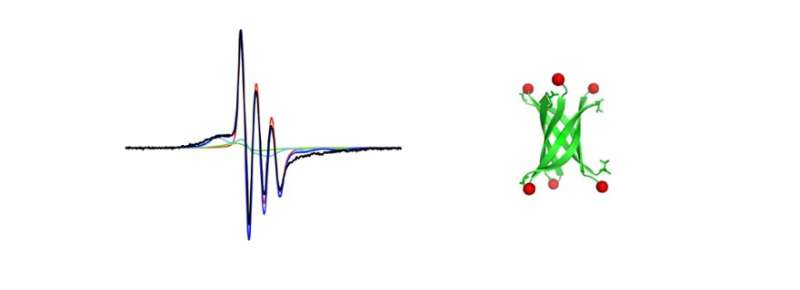How an Alzheimer's-related protein forms plaques

Neurological diseases such as Alzheimer's disease are characterised by aggregates of protein in the brain. The connection of these aggregates to the disease itself is unclear. Martina Huber, Enrico Zurlo and colleagues published a new method to monitor the formation of these aggregates.
While they are clumping together, the proteins first form aggregates of several molecules, named oligomers. These may aggregate further, until they form the large aggregates or plaques, that have been found in the brains of people with Alzheimer's disease.
"For a long time, it has been thought that these plaques cause the brain damage, but more and more evidence suggests that it may be the oligomers that do the damage," says Martina Huber.
Spin Label
However, detecting the oligomers is very difficult, she adds. "They don't form one single structure, but they can aggregate in several different ways, like clumps of spaghetti." Her group uses Electron Paramagnetic Resonance (EPR) to follow the aggregation, using a spin label, a special molecule that has a stable, non-paired electron.
TOAC
In a strong magnetic field (around 3.35 Tesla in this case), these unpaired electrons absorb 95 GHz microwave radiation. The exact shape of the absorption graph can yield information about the speed with which of the molecules revolve around their axis. The researchers used chemical synthesis to couple a spin label, a molecule named TOAC, to artificial proteins that resemble the proteins in plaques. Then, they followed the aggregation process for seven days.
Neurodegenerative diseases
They noticed how the rotation speed of the TOAC labels decreased slowly. Larger aggregates revolve slower than small aggregates, Huber explains, 'so that means that the proteins occur in aggregates of growing size."
By tracking the exact decrease of the rotation speed, the researchers could follow the evolution of the oligomers. They concluded that they consist of aggregates of either five to six proteins, or 15 to 18 proteins.
These are artificial proteins in a watery solution, but Huber expects that the new measurement technique can be useful in solving the role of plaques in neurodegenerative diseases like Alzheimer's disease.
The research is on artificial proteins in a watery solution, but Huber expects that the new technique can be useful in explaining the role of plaques in neurodegenerative diseases. "We have shown that this is a good method for tracking the evolution of the oligomers," she says, "something that is very hard to do with any other method."
More information: E. Zurlo et al. Tracking amyloid oligomerization with monomer resolution using a 13-amino acid peptide with a backbone-fixed spin label, Physical Chemistry Chemical Physics (2019). DOI: 10.1039/C9CP01060B




















